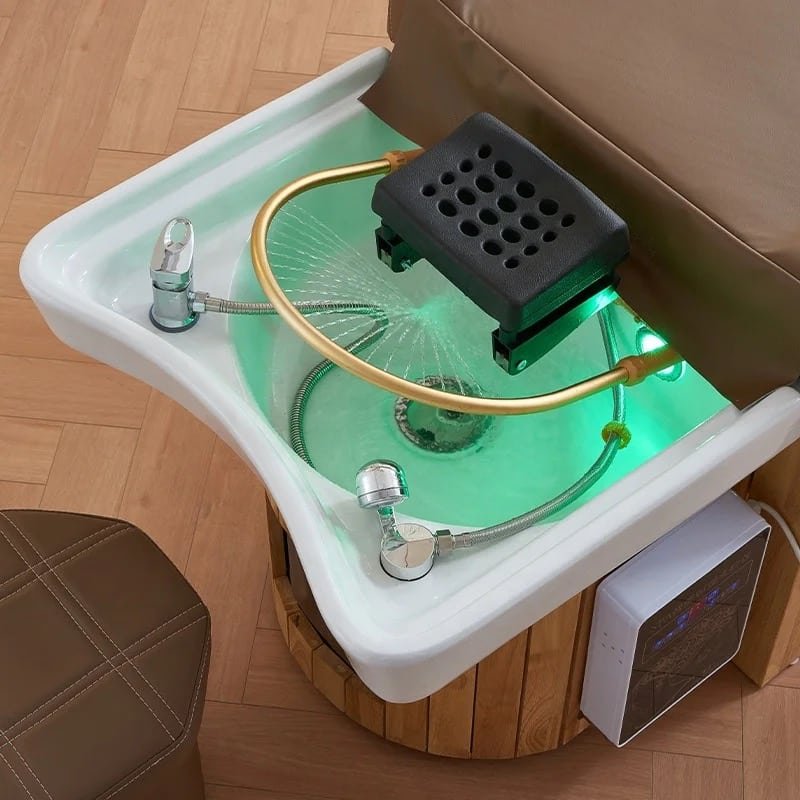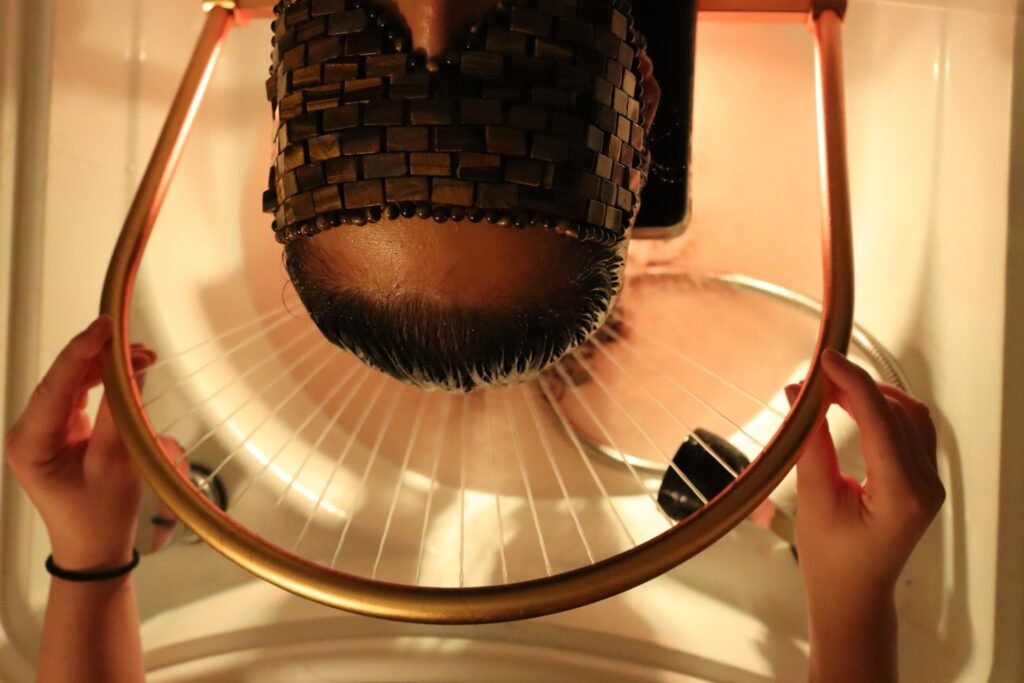Discover how innovative interior design transforms the sensory experience of a Japanese head spa. Immerse yourself in a world where aesthetics meet ultimate relaxation. In this article, we explore the elements that make this space a sanctuary of modern well-being. Learn how every detail is carefully designed to soothe the senses and offer an unparalleled moment of relaxation. You won't want to miss this fascinating dive into the world of design, where tradition and modernity come together to elevate the art of spa to new heights.
Choosing the Theme and Ambiance for a Successful Japanese Head Spa Design
Creating the perfect design for a Japanese head spa is not just about elaborate decoration but also about a subtle interplay of colors, materials, and lighting. Imagine a space that transports your clients to a haven of peace. What better way to achieve this than by using elements that evoke Japanese serenity and harmony?
Japanese Aesthetics: Materials and Colors
Japanese aesthetics are synonymous with simplicity and elegance. For a Japanese head spa, use natural materials such as wood, stone, and bamboo. These materials bring warmth and a sense of calm. Additionally, opt for a soft and neutral color palette, including shades of beige, white, and light brown.
Wood and stone are not only visually appealing but also practical, requiring minimal maintenance. They also help absorb sound, creating a peaceful atmosphere. As a result, your clients will immediately feel disconnected from everyday stress.
Popular Materials List
-
Wood (oak, bamboo)
-
Stone (slate, marble)
-
Rice paper (Japanese screens)
Integrating Natural Elements
Incorporating natural elements is essential to capturing the zen ambiance of a Japanese spa. Consider placing a few bonsai trees, potted bamboo, or even a small water fountain. This creates a healthy environment and enhances clients' well-being.
Plants purify the air, add a touch of greenery, and promote a peaceful state of mind. Furthermore, the gentle sound of flowing water is one of the best ways to evoke a sense of total relaxation.
Soft Lighting: Illumination and Atmosphere
Lighting plays a crucial role in designing a Japanese head spa. Use dimmable lamps and lanterns for a soft glow. This helps control the ambiance and adds an intimate, soothing touch.
The use of paper lanterns and scented candles enhances the atmosphere while diffusing a warm and welcoming light. Proper lighting management can completely transform a space, making it more comfortable and conducive to relaxation.
Lighting Inspiration Table
| Type of Lighting | Description |
|---|---|
| Soft lights | Creates a gentle ambiance |
| Lanterns | Evokes traditional charm |
| Scented candles | Adds a sensory touch |
Conclusion
A successful Japanese Head Spa design relies on a careful balance of natural materials, nature-inspired elements, and thoughtfully planned lighting. Would you consider integrating these concepts to create a magical ambiance in your spa?

Choosing the Theme and Ambiance for a Successful Japanese Head Spa Design
Creating the perfect design for a Japanese head spa is not just about elaborate decoration but also about a subtle interplay of colors, materials, and lighting. Imagine a space that transports your clients to a haven of peace. What better way to achieve this than by using elements that evoke Japanese serenity and harmony?
Japanese Aesthetics: Materials and Colors
Japanese aesthetics are synonymous with simplicity and elegance. For a Japanese head spa, use natural materials such as wood, stone, and bamboo. These materials bring warmth and a sense of calm. Additionally, opt for a soft and neutral color palette, including shades of beige, white, and light brown.
Wood and stone are not only visually appealing but also practical, requiring minimal maintenance. They also help absorb sound, creating a peaceful atmosphere. As a result, your clients will immediately feel disconnected from everyday stress.
Popular Materials List
-
Wood (oak, bamboo)
-
Stone (slate, marble)
-
Rice paper (Japanese screens)
Integrating Natural Elements
Incorporating natural elements is essential to capturing the zen ambiance of a Japanese spa. Consider placing a few bonsai trees, potted bamboo, or even a small water fountain. This creates a healthy environment and enhances clients' well-being.
Plants purify the air, add a touch of greenery, and promote a peaceful state of mind. Furthermore, the gentle sound of flowing water is one of the best ways to evoke a sense of total relaxation.
Soft Lighting: Illumination and Atmosphere
Lighting plays a crucial role in designing a Japanese head spa. Use dimmable lamps and lanterns for a soft glow. This helps control the ambiance and adds an intimate, soothing touch.
The use of paper lanterns and scented candles enhances the atmosphere while diffusing a warm and welcoming light. Proper lighting management can completely transform a space, making it more comfortable and conducive to relaxation.
Lighting Inspiration Table
| Type of Lighting | Description |
|---|---|
| Soft lights | Creates a gentle ambiance |
| Lanterns | Evokes traditional charm |
| Scented candles | Adds a sensory touch |
Conclusion
A successful Japanese Head Spa design relies on a careful balance of natural materials, nature-inspired elements, and thoughtfully planned lighting. Would you consider integrating these concepts to create a magical ambiance in your spa?
Design and Ergonomics of Treatment Spaces in Japanese Head Spa Layout
Welcome to the world of interior design and ergonomics for treatment spaces in Japanese head spas. In this section, we will focus on the effective organization and utilization of space, which are essential for creating a setup that is not only aesthetically pleasing but also highly functional. Smooth circulation and the comfort of both clients and staff are paramount, while the furniture should align with the Japanese ambiance.
Smooth Circulation in a Japanese Head Spa Layout
When we talk about smooth circulation, imagine a space where everything flows naturally. This means that neither clients nor staff should encounter obstacles in their path. To achieve this, each area of the spa must be optimized so that treatments can be delivered with serenity.
Organizing the space efficiently is not just a time-saver; it also enhances comfort. By minimizing interruptions and overlaps, everyone feels more at ease. When everything goes as planned, the positive energy of the space naturally radiates.
Separation of Spaces in a Japanese Head Spa Layout
Carefully dividing the spaces within a Japanese spa creates an immersive and personalized experience. It is important to properly delineate treatment, waiting, and relaxation areas so that each moment is unique and tailored to clients' needs.
Partitions can be created using subtle yet charming elements such as wooden screens or traditional Japanese curtains. These elements help establish a relaxing atmosphere and ensure privacy while maintaining the Japanese aesthetic. A well-organized layout makes every corner of your spa feel welcoming, enhancing the overall guest experience.
Comfortable Furniture for a Japanese Head Spa Layout
Finally, let's discuss furniture selection. Choosing ergonomic and comfortable furniture is crucial for treatment spaces. Reclining chairs, for instance, should be designed to provide both easy access for treatments and maximum comfort for clients. Wooden coffee tables and plush cushions enhance the warm and inviting atmosphere.
Balancing practicality with aesthetics benefits your spa’s image. Imagine your clients feeling at home, fully immersed in a wellness session without a care for the outside world. This is a valuable asset for client retention!
Examples of Comfortable Furniture in a Japanese Head Spa
-
Reclining chairs adapted for treatments.
-
Wooden coffee tables for a natural ambiance.
-
Cushions or cozy tatamis in the waiting area.
Summary Table of Ergonomic Layout
| Elements | Benefits | Impact on Experience |
|---|---|---|
| Smooth circulation | Facilitates movement | Enhances comfort |
| Space separation | Encourages privacy and immersion | Enriches experience |
| Ergonomic furniture | Improves treatment comfort | Boosts satisfaction |
By combining smooth circulation, proper space separation, and well-chosen furniture, you lay the foundation for a successful Japanese Head Spa Layout. Each of these components contributes to creating a harmonious ambiance, ideal for delivering an unparalleled experience. So, how do you envision your own treatment space? Remember, ergonomics benefits not only your clients but also your team, optimizing overall operations.

FAQ - Interior Design of a Japanese Head Spa
1. What are the key elements of a Japanese spa interior design?
A Japanese spa design is based on simplicity and harmony. It typically incorporates natural materials such as wood and stone. Soft lighting is essential to create a soothing atmosphere. Green plants add freshness and tranquility. For example, bonsai trees or bamboo are often used as decorative elements.
2. Why is lighting important in a Japanese spa?
Lighting plays a crucial role in the ambiance of a spa. Dim, soft lighting creates a relaxing setting. It reduces stress and promotes relaxation. The use of lanterns or candles is common, helping to establish a serene and peaceful atmosphere that inspires tranquility.
3. How do natural materials influence the spa experience?
Natural materials, such as wood and stone, provide a sense of warmth. They create a connection with nature, enhancing the benefits of relaxation. A wooden floor or smooth stone walls can reinforce this natural and calming ambiance.
4. What colors are typically used in a Japanese spa?
Japanese spas favor soft and neutral colors. White, green, and beige are popular choices, as they encourage relaxation. These colors also help create a serene and balanced space. Other soft colors, such as pale blue, are sometimes used to add a touch of freshness.
5. What decorative elements are common in Japanese spas?
Decorative elements often include ceramic objects and subtle wall paintings. Bamboo tatami mats are frequently used for flooring. Water fountains are common to create a soothing sound. Zen stones can also be arranged to strengthen the connection to nature.


